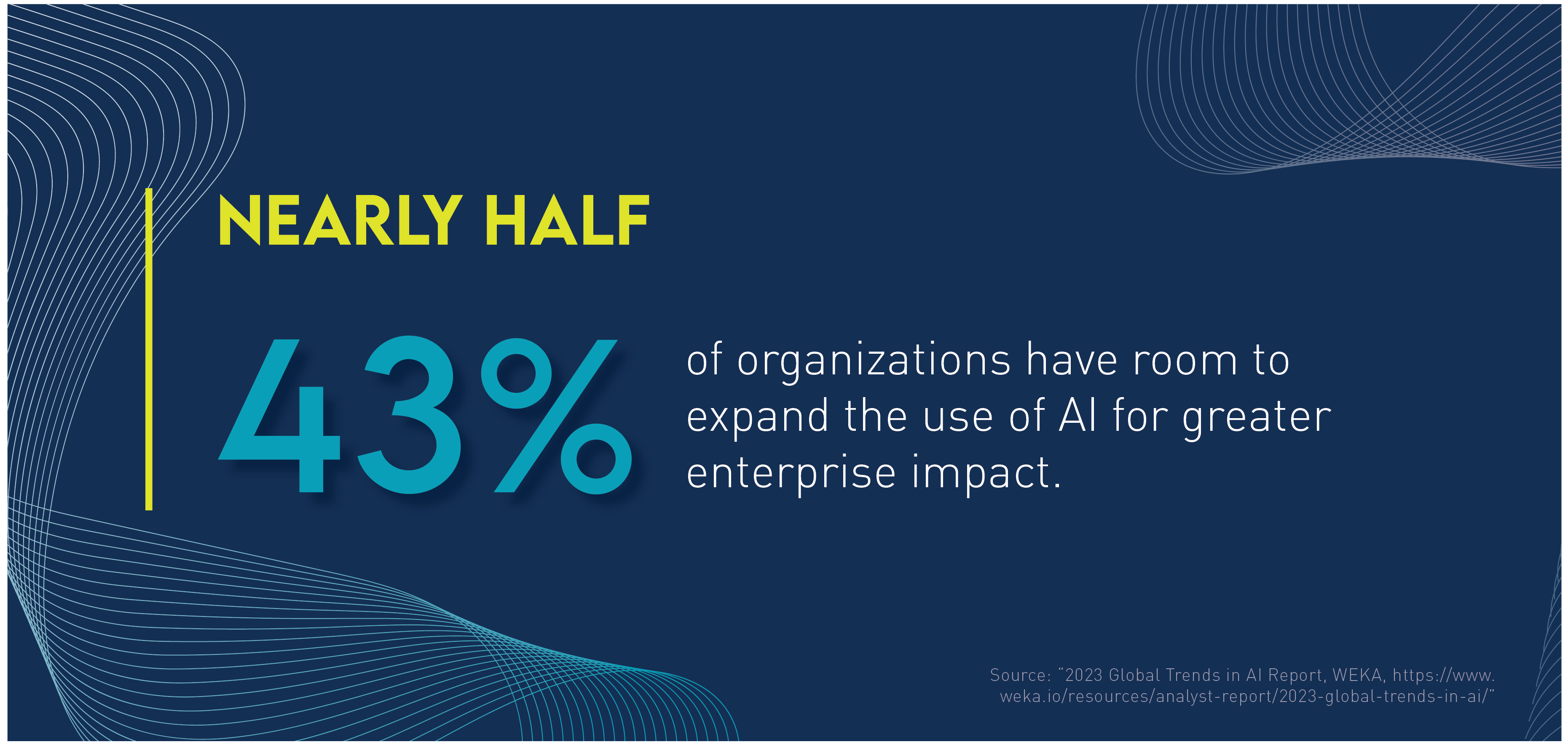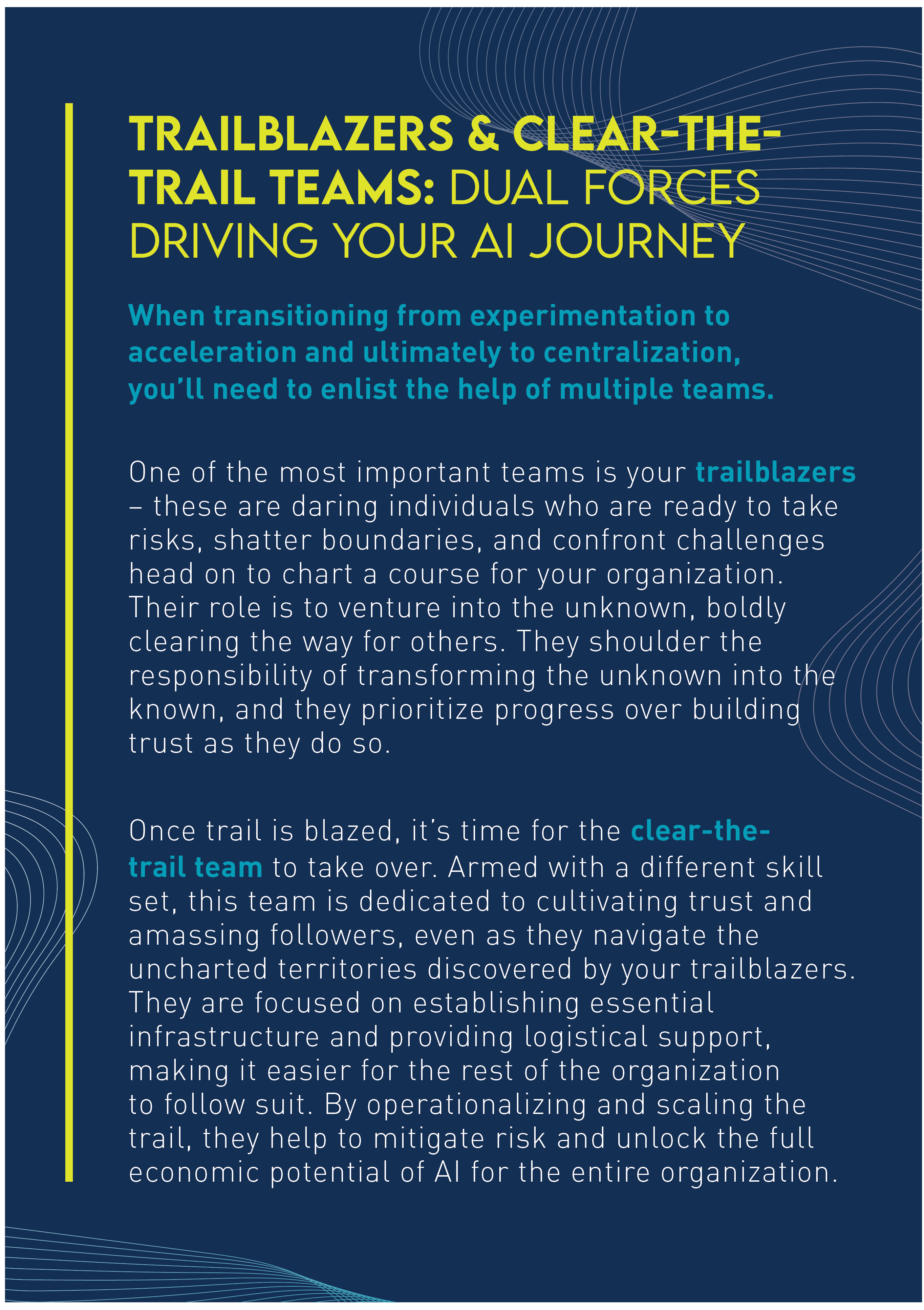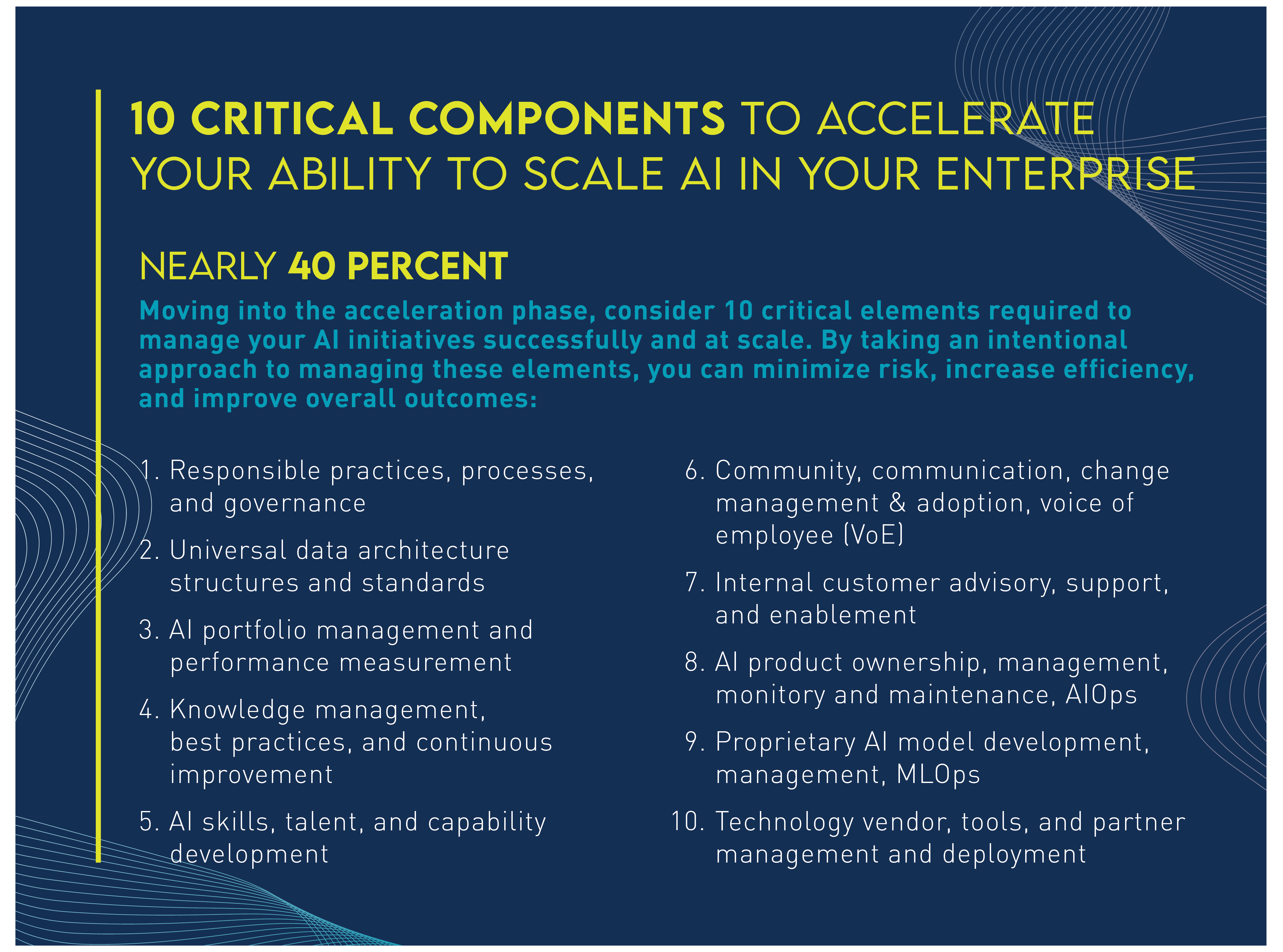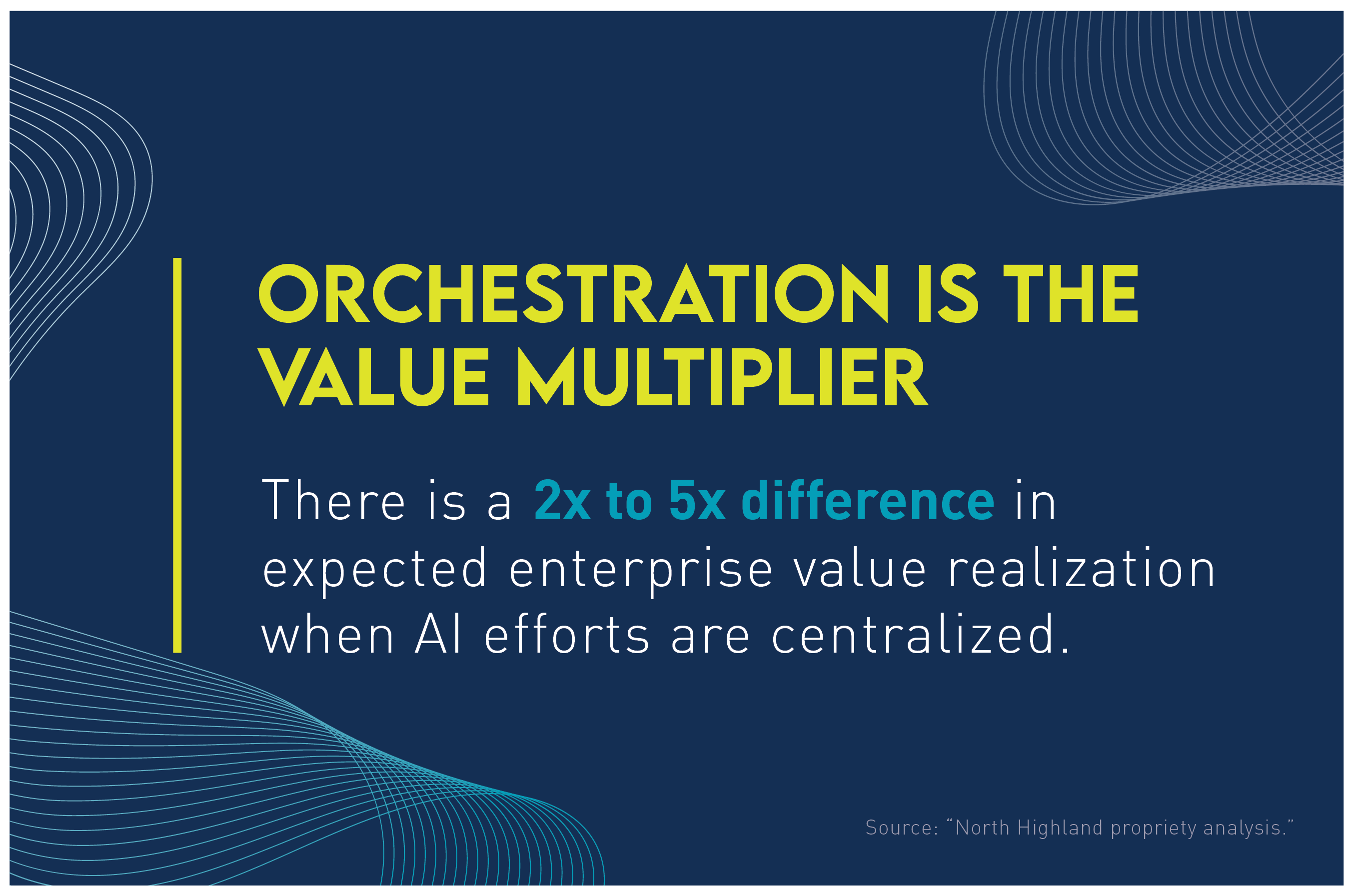In an age of unforeseen complexity, artificial intelligence (AI) stands out as a potential force multiplier affecting every dimension of the C-suite agenda. Its disruptive influence on the enterprise value model has the power to eliminate many historical tradeoffs for senior leaders, generating new possibilities in tandem with heightened interest from stakeholders, investors, and boards.
With interest comes opportunity – and the opportunity at hand is immense: The AI market is on track to reach a staggering $407 billion by 2027, experiencing substantial growth from its estimated $86.9 billion revenue in 2022. And within this expansive landscape, generative AI is one facet brimming with potential: It alone could drive a seven percent increase in global GDP and lift productivity growth by 1.5 percentage points over 10 years.

Productivity—an imperative in the face of a diminishing workforce and escalating demands—requires a proactive strategy. And AI introduces a new paradigm for how that strategy should look, setting a new (higher) standard for productivity and, ultimately, performance. With its capabilities, routine and predictable activities could be eliminated from employees’ plates. This strategic shift positions individuals to operate at the highest level of their roles and allows work that gets in the way of high-value productivity to be outsourced to AI technology.
To actively contribute to this transformative growth and fully unlock the benefits of AI, your organization must go beyond mere exploration and experimentation with these evolving technologies—you’ll need to create an AI-enabled enterprise.
But many companies encounter barriers in scaling their AI efforts to build such an enterprise. Formidable organizational and cultural challenges—not the technology itself—tend to slow down progress.
Leaders and teams are struggling to move from experimenting with small-scale proofs of concepts that solve an isolated business challenge to orchestrating organization-wide initiatives with the power to drive change across the company. In fact, just 19 percent of companies surveyed by Gartner in May 2023 are in AI piloting and production, while 70 percent say they are still in experimentation mode.
Becoming an AI-enabled enterprise isn’t a journey that proceeds in a straight line to a defined destination. Instead, it requires testing a hypothesis and adjusting along the way. And it proceeds in three phases—from experimentation to acceleration to orchestration—each of which requires more organizational confidence and momentum than the last.
In an earlier blog, we discussed the role of experimentation in the AI-enabled enterprise, detailing how early AI efforts should focus on quick impact and learning. We explained how you can overcome the painful learning curve associated with AI by focusing on AI’s “Five First”:
- Leading with people
- Establishing trust
- Democratizing access
- Starting a movement
- Prioritizing learning

In this blog, we build on that thinking and describe how you can transition from experimentation to acceleration and then to orchestrating your AI efforts enterprise-wide. Before we dive in, there’s one important point we’d like to highlight related to your people: You’ll need multiple teams to make this transition.
- The first team consists of your trailblazers who are going fast, breaking things, and burning through the forest to get to the other side.
- Then, your clear-the-trail team takes over, smoothing the pathway so the other wagon trains can follow. This team is focused on establishing the necessary infrastructure and logistical support to make it easier for those who follow in their footsteps.
The skills and capabilities of those who blaze the trail are different from the clear-the-trail team that operationalizes and scales, but both are key to your ability to mitigate risk and unlock the full economic potential of AI.
With that in mind, let’s begin.
The Acceleration Phase
You don’t have to wait to see the impact of experimenting with AI—it’s immediate. Sitting on the sidelines and avoiding experimentation, whether due to fear over the risks, a belief that the technology isn’t ready to be deployed in your business, or any other reason, will put you at the very real risk of getting left behind.
While we don't yet fully know what the advantage of success with AI is, we do know that it could be so revolutionary that it may even spell the end of entire businesses that fail to harness its potential.
You have to experiment, evaluate, and be participatory; however, the challenge is finding the right balance. Jumping in with too much vigor and intensity might limit your strategic options if things don’t unfold as initially planned.
The question then becomes: How can you build momentum and inspire the entire organization to get on board while still maintaining a strategic perspective? Striking this delicate balance is the primary objective of the acceleration phase.
As you move from experimentation to acceleration, your teams will transition their focus from merely experimenting to enabling impact quickly. Yes, you're still getting your ducks in a row and your data in order, but now you're also moving swiftly and decisively.
Importantly, this does not require a perfect environment. It’s about avoiding getting too bogged down in “planning the perfect plan” and instead directing your efforts toward taking decisive action so that you can identify and overcome your key barriers to scale.
Your trailblazers will play a vital role in this phase. They will drive progress and much of the work. They’re not only clearing the way, but also offering support to help people bring their ideas to life, at scale.
Telling your stories
Quick wins and strategic storytelling are key components of this phase. An organization’s own piloting and experimentation journey is the story its leaders need to tell to inspire the rest of the organization to come along for the ride. The process of scaling builds a compelling story that inspires the organization to lean in – and helps expedite employees' adoption – as you move toward orchestrating your capabilities enterprise-wide. By showcasing a series of quick wins and telling their stories, you can effectively prepare employees to adapt and embrace AI in their day-to-day ways of working.
The narrative of your organization’s piloting and experimentation should not just be a highlight reel, however; it should be a genuine account that acknowledges failures and limitations. You can ensure this by candidly discussing challenges, openly acknowledging any setbacks, and articulating lessons learned, plus your plan to improve or overcome limitations.
This balanced storytelling approach will help you build credibility and trust – in your organization, in the journey you are on, and in the future of your business. It will help to inspire your people to navigate challenges collectively and help to create a culture of continuous improvement. As you move toward scaling capabilities enterprise-wide, your commitment to transparency and problem-solving will become a cornerstone for maintaining trust and encouraging widespread employee adoption.
Managing the change
Change management also becomes crucial as you accelerate your AI efforts, with repetition playing a central role. Did you know that people need to hear a message five to seven times to change their minds and use new information to guide their decision-making and actions?
Importantly, when you are accelerating and managing the significant amount of change that comes with that, you must be intentional about bringing both intellectual and behavioral change into focus. This is critical for mitigating the negative impacts that the introduction of AI may have on people:
- Intellectual change is about developing new ways of thinking and understanding. When it comes to AI, there are new concepts, technologies, and processes that your employees will need to learn and digest to effectively work with your AI systems.
- Behavioral change is about adjusting how you work, make decisions, and interact with others. As AI systems become more prevalent in your business, your employees will need to adapt their processes, embrace new tech, and collaborate with AI systems and team members in new ways.
As part of the acceleration phase, it’s also critical to reposition AI enablement from a human vs. machine dynamic to a cooperative model where humans coach the machine. Cultivating a collaborative relationship between humans and AI is the key, rather than creating competition between the two. All of the bot experiments where humans were pitted against machines failed because humans are creative and ingenious enough to lead AI to failure if they are not bought in. And the more you rely on AI, the more catastrophic the impact of that internal sabotage can be.
Rather than viewing AI as a replacement, it should be used as a tool to support employees and transform the way work is done. Through this approach, AI can be used to enhance processes and workflows without replacing individuals or eliminating jobs.

The Orchestration Phase
As your business continues to deploy AI, you will increasingly create centralized AI groups designed to strategize, prioritize, establish governance and structures, and spread AI knowledge and skills across the organization. You will also create a unified and competent approach, providing employees with a shared understanding of AI to build upon.
But it’s not about orchestration for orchestration’s sake. This critical step will allow you to maximize the impact of your AI efforts. Only those organizations that are intentional and manage, enable, and govern efforts at the enterprise level will successfully mitigate risk and realize the full economic potential of AI.
In fact, our recent analysis indicates that there is a 2x to 5x difference in expected enterprise value realization when AI efforts are centrally orchestrated.
Here’s how you get there:
In this phase, you’ll have clear-the-trail teams who are performing most of the work and are charged with enabling AI across the enterprise. Specifically, they will:
- Take what has been trailblazed (in the experimentation and acceleration phases) and make it work for everyone.
- Identify use cases, ideas, and opportunities within the business.
- Work with the business to manifest value and learn.
- Bring those learnings back to a centralized body that can codify them so they can be applied to the next big idea—all to ensure that no value is wasted.
 During this orchestration phase, you should also begin to establish some common standards, common tech platforms, and standardize certain aspects of AI so everyone in your organization – not just the dedicated clear-the-trail teams – is enabled to do their best work and accelerate value.
During this orchestration phase, you should also begin to establish some common standards, common tech platforms, and standardize certain aspects of AI so everyone in your organization – not just the dedicated clear-the-trail teams – is enabled to do their best work and accelerate value.
Through the experimentation and acceleration phases, your organization learned to interpret, act on, and apply implicit, explicit, and tacit knowledge in new and different ways. You laid the foundation to harvest the knowledge required for automation in the orchestration phase.
Now, you’re positioned to achieve AI enablement in which employees have a single set of working agreements and interpretations on which to build. This understanding becomes the alignment engine for the organization—when everyone can agree on the ground truth, they are more likely to align around priorities and move in the same direction.
By offering centralized support to help people experiment more quickly and disseminate learnings, you can also build organizational capability around AI. Capability mobility is an important part of this – and a critical step in moving from experimentation to centralization. Mobility unlocks the value of capability as an asset, so you can take what you learn and make the organization better.
In essence, this is about shifting from focusing on economies of scale to economies of expertise, with the expertise of a combination of humans and machines. When people are given tools that amplify their collective ability to generate something, it enables a shift from the company codifying its knowledge and producing widgets to codifying its expertise and creating solutions, products, services, and solutions.
Parting Thoughts: Becoming an AI-Enabled Enterprise
Experimentation, acceleration, and the orchestration of your AI efforts—these three stages collectively pave the way for AI enablement within the organization.
But keep in mind, if you lose momentum at any point, you won’t be able to reach the next stage—there’s simply too much organizational treacle. You’ll see progress slow or stall altogether, and it might feel like you’re stuck in the cycle of taking one step forward and two steps back.
Our experts can help you navigate these three stages and meet you where you are on your journey to AI-enablement.
Whether it’s harvesting knowledge, scaling architecture, addressing model bias, governance, KPIs, or stakeholder management, our experience in this space positions us to help you move through the learning curve more quickly and accelerate speed to value.
Serving as strategic advisors, we offer insights on various specialized areas that help you move toward maturity—from constructing large language models to exploring commercial opportunities. Our collaborative teaming approach provides diversity in skill sets and helps you develop capability, whether you need trailblazers or clear-the-trail teams. Our focus is on enabling AI adoption, with intentionality and an emphasis on intellectual and behavioral change, rather than job elimination.
AI has the potential to be a game-changer across your C-suite agenda. By moving beyond experimentation and into acceleration and, ultimately, orchestrating your AI capabilities organization-wide, you can empower teams, drive impact quickly, and ensure that key learnings are used to deliver significant value across your organization.
RELATED CONTENT





